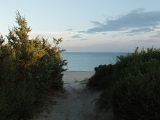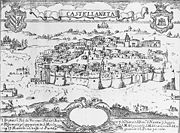
Castellaneta
Encyclopedia
Castellaneta is a city and comune
in the province of Taranto
, in the Puglia region of Southern Italy
, about 40 km from Taranto
. Located in a territory spanning from the Murgia
to the Ionian Sea
, characterized by numerous gravina
ravines, it is part of the Comunità Montana della Murgia Tarantina (Tarentine Murgia
Mountain Community).
 Human settlements were present in the area since the Bronze Age
Human settlements were present in the area since the Bronze Age
(3rd-2nd millennium BC), and it was later probably settled by Sicels
, Messapii
and Iapyges
.
According to a theory, a fortified city (Castania in Latin) was founded in 550 and grew in size when the population of neighboring cities fled there from Saracen
attacks. Other historians maintain instead that it was a Greek colony which existed until the 8th century. When the Saracens destroyed it, the inhabitants joined in a Castellum Unitum (United Castle) on the hills, whence the current name.
Whatever its origin, Castellaneta was conquered by the Normans in 1064, taken by Duke Robert of Taranto, who expelled its Byzantine inhabitants. At that time, probably, the episcopal see was created. In the 13th century Charles of Anjou turned it first into a fief, and later into a King's city.
In 1503, during the Italian Wars
, the citizens pushed back a French occupation force under the Duke of Nemours
, in the so-called "Sack of Castellaneta". In 1519 the Spaniards sold it to Flemish feudataries, and thenceforth the city started to decline as secondary center.
In the course of World War II
, the withdrawing Germans
bombed it, killing 27 people. For this feat the city received a bronze medal to civil valor.

was born in Castellaneta in 1895.
Dan Castellaneta
Comune
In Italy, the comune is the basic administrative division, and may be properly approximated in casual speech by the English word township or municipality.-Importance and function:...
in the province of Taranto
Province of Taranto
The Province of Taranto is a province in the Apulia region of Italy. Its capital is the city of Taranto.It has an area of 2,437 km², and a total population of 580,588...
, in the Puglia region of Southern Italy
Italy
Italy , officially the Italian Republic languages]] under the European Charter for Regional or Minority Languages. In each of these, Italy's official name is as follows:;;;;;;;;), is a unitary parliamentary republic in South-Central Europe. To the north it borders France, Switzerland, Austria and...
, about 40 km from Taranto
Taranto
Taranto is a coastal city in Apulia, Southern Italy. It is the capital of the Province of Taranto and is an important commercial port as well as the main Italian naval base....
. Located in a territory spanning from the Murgia
Murgia
Murgia is a sub-region of Apulia in southern Italy, corresponding to a karst topographic plateau of rectangular shape, occupying the central area of the region. The name stems from the Latin murex, meaning "sharp stone"....
to the Ionian Sea
Ionian Sea
The Ionian Sea , is an arm of the Mediterranean Sea, south of the Adriatic Sea. It is bounded by southern Italy including Calabria, Sicily and the Salento peninsula to the west, southern Albania to the north, and a large number of Greek islands, including Corfu, Zante, Kephalonia, Ithaka, and...
, characterized by numerous gravina
Gravina
Gravina may refer to:* Gravina in Puglia in Southern Italy* The Gravina, a river in southern Italy* the Duchy of Gravina and the ducal family of Orsini-Gravina* the Bishopric of Gravina and Montepeloso...
ravines, it is part of the Comunità Montana della Murgia Tarantina (Tarentine Murgia
Murgia
Murgia is a sub-region of Apulia in southern Italy, corresponding to a karst topographic plateau of rectangular shape, occupying the central area of the region. The name stems from the Latin murex, meaning "sharp stone"....
Mountain Community).
History

Bronze Age
The Bronze Age is a period characterized by the use of copper and its alloy bronze as the chief hard materials in the manufacture of some implements and weapons. Chronologically, it stands between the Stone Age and Iron Age...
(3rd-2nd millennium BC), and it was later probably settled by Sicels
Sicels
The Sicels were an Italic people who inhabited ancient Sicily. The Sicels gave Sicily the name it has held since antiquity, but they rapidly fused into the culture of Magna Graecia.-History:...
, Messapii
Messapii
thumb|220px|Messapic ceramic, Archaeological Museum of [[Oria, Italy|Oria]], Apulia.The Messapii were an ancient tribe that inhabited, in historical times, the south-eastern peninsula or "heel" of Italy , known variously in ancient times as Calabria, Messapia and Iapygia...
and Iapyges
Iapyges
The Iapyges or Iapygians were an Indo-European people who inhabited the heel of Italy before being absorbed by the Romans.-Identity:The Iapyges have unknown origins but could have been from Illyria....
.
According to a theory, a fortified city (Castania in Latin) was founded in 550 and grew in size when the population of neighboring cities fled there from Saracen
Saracen
Saracen was a term used by the ancient Romans to refer to a people who lived in desert areas in and around the Roman province of Arabia, and who were distinguished from Arabs. In Europe during the Middle Ages the term was expanded to include Arabs, and then all who professed the religion of Islam...
attacks. Other historians maintain instead that it was a Greek colony which existed until the 8th century. When the Saracens destroyed it, the inhabitants joined in a Castellum Unitum (United Castle) on the hills, whence the current name.
Whatever its origin, Castellaneta was conquered by the Normans in 1064, taken by Duke Robert of Taranto, who expelled its Byzantine inhabitants. At that time, probably, the episcopal see was created. In the 13th century Charles of Anjou turned it first into a fief, and later into a King's city.
In 1503, during the Italian Wars
Italian Wars
The Italian Wars, often referred to as the Great Italian Wars or the Great Wars of Italy and sometimes as the Habsburg–Valois Wars, were a series of conflicts from 1494 to 1559 that involved, at various times, most of the city-states of Italy, the Papal States, most of the major states of Western...
, the citizens pushed back a French occupation force under the Duke of Nemours
Louis d'Armagnac, Duke of Nemours
Louis d'Armagnac, Duke of Nemours , known for most of his life as the Count of Guise, was the third son of Jacques d'Armagnac, Duke of Nemours and Louise of Anjou....
, in the so-called "Sack of Castellaneta". In 1519 the Spaniards sold it to Flemish feudataries, and thenceforth the city started to decline as secondary center.
In the course of World War II
World War II
World War II, or the Second World War , was a global conflict lasting from 1939 to 1945, involving most of the world's nations—including all of the great powers—eventually forming two opposing military alliances: the Allies and the Axis...
, the withdrawing Germans
Wehrmacht
The Wehrmacht – from , to defend and , the might/power) were the unified armed forces of Nazi Germany from 1935 to 1945. It consisted of the Heer , the Kriegsmarine and the Luftwaffe .-Origin and use of the term:...
bombed it, killing 27 people. For this feat the city received a bronze medal to civil valor.
Main sights

- The Cathedral (Chiesa di San Nicola) was built in 1220 but was totally remade in the 18th century, along BaroqueBaroque architectureBaroque architecture is a term used to describe the building style of the Baroque era, begun in late sixteenth century Italy, that took the Roman vocabulary of Renaissance architecture and used it in a new rhetorical and theatrical fashion, often to express the triumph of the Catholic Church and...
lines. Noteworthy are the façade and three canvasses by Carlo Porta. Annexed is the Palazzo Vescovile (Bishops' Palace), housing other works of art. The cathedral is named after Saint NicholasSaint NicholasSaint Nicholas , also called Nikolaos of Myra, was a historic 4th-century saint and Greek Bishop of Myra . Because of the many miracles attributed to his intercession, he is also known as Nikolaos the Wonderworker...
, whose relics are held in the nearest big city, BariBariBari is the capital city of the province of Bari and of the Apulia region, on the Adriatic Sea, in Italy. It is the second most important economic centre of mainland Southern Italy after Naples, and is well known as a port and university city, as well as the city of Saint Nicholas...
. - San Domenico, with a façade in both RenaissanceRenaissance architectureRenaissance architecture is the architecture of the period between the early 15th and early 17th centuries in different regions of Europe, demonstrating a conscious revival and development of certain elements of ancient Greek and Roman thought and material culture. Stylistically, Renaissance...
and Baroque styles. - San Francesco d'Assisi (1471), with canvasses from the 17th century.
- Santa Maria della Luce (13th century), is one of the few example of Angevine-Gothic architectureGothic architectureGothic architecture is a style of architecture that flourished during the high and late medieval period. It evolved from Romanesque architecture and was succeeded by Renaissance architecture....
in the area, along with the Cathedral's bell tower. Built on uneven terrain, it is in the shape of a ship's deck, and has interesting frescoes in the interior. - The Gravina of Castelleneta and numerous carved caves, once inhabited by local population, some of them used as churches.
Famous people
Actor Rudolph ValentinoRudolph Valentino
Rudolph Valentino was an Italian actor, and early pop icon. A sex symbol of the 1920s, Valentino was known as the "Latin Lover". He starred in several well-known silent films including The Four Horsemen of the Apocalypse, The Sheik, Blood and Sand, The Eagle and Son of the Sheik...
was born in Castellaneta in 1895.
Dan Castellaneta
Dan Castellaneta
Daniel Louis "Dan" Castellaneta is an American actor, voice actor, comedian, singer and screenwriter. Noted for his long-running role as Homer Simpson on the animated television series The Simpsons, he voices many other characters on The Simpsons, including Abraham "Grampa" Simpson, Barney Gumble,...

